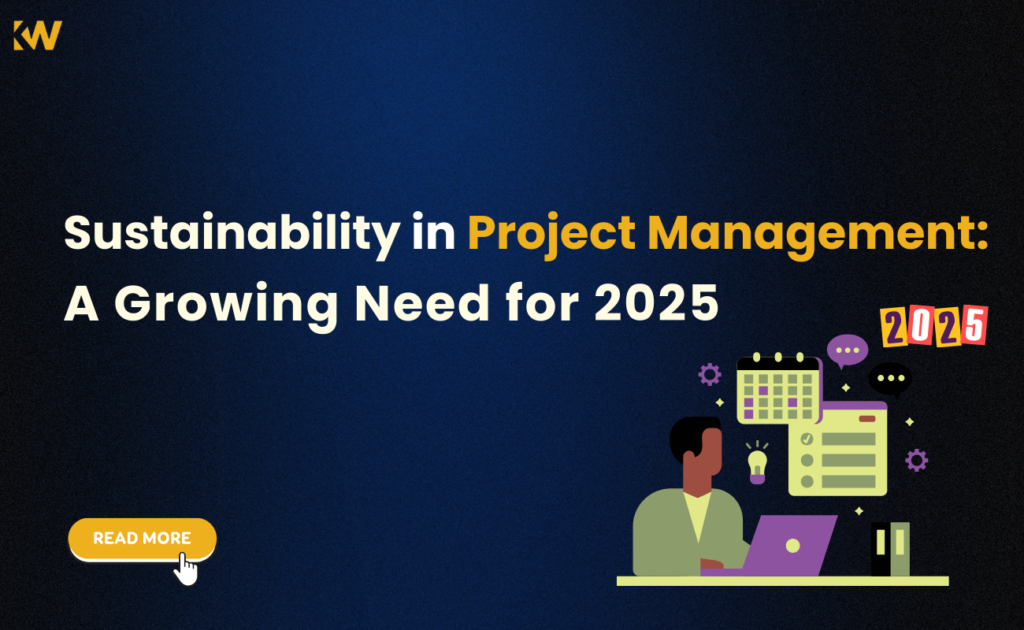In the last few times, sustainability has evolved into more than an idea; it’s an essential requirement. As we move into 2025 sustainability in the field of project management is taking place in the forefront. Companies, government agencies and other stakeholders are now realizing the importance of balancing economic growth and social and environmental accountability. This blog discusses the increasing significance of sustainable management of projects and how project managers can adapt to these requirements.

The Rise of Sustainability in Project Management
Sustainability is not only concerned with “going green.” It is about implementing methods that guarantee the sustainability of resources over time and meet the requirements of all stakeholders. In the case of project directors, it involves including sustainability considerations throughout the entire project’s lifecycle, from the planning stage to execution and closing.
The key drivers for this shift are:
- Environment-related Concerns: The effects of climate change, depletion of natural resources as well as waste management, are urgent global concerns.
- Regulative Pressures: Globally, governments are imposing more stringent social and environmental regulations.
- The expectations of stakeholders: Customers, investors and communities are demanding ethical business practices.
- Corporate Social Responsibilities (CSR): Organizations are integrating sustainability into their strategies to boost their brand and efficiency in operation.
What Does Sustainability in Project Management Look Like?
The concept of sustainability in the management of projects is all about managing three bottom lines, which include environmental, economic and social impact. Here’s how:
1. Environmental Sustainability
- Green Procurement: Securing products and services with little environmental impact.
- Energy Efficiency: The goal is to reduce the use of electricity throughout the lifecycle of the project.
- Recycling and Waste Management: Adopt practices that reduce the use, recycle and recycle recyclable materials.
2. Economic Sustainability
- Cost efficiency: Insuring the efficient use of financial resources without compromising sustainability objectives.
- Long-term benefit: Investing in solutions that will provide long-term advantages over short-term gains.
3. Social Sustainability
- Participation of Stakeholders: Participating communities employees, customers as well as other stakeholders in the decision-making process.
- Diversity and inclusion: Promoting fair opportunities for everyone.
- Ethical practices: Ensure fair work conditions and respect for the rights of humans.
Integrating sustainability into project Management
To incorporate sustainability into project management take a look at these strategies:
- 1. Adopt Sustainable Project Frameworks
Frameworks like PRiSM (Projects Integrating Sustainable Methods) are designed for sustainability-focused project management.
- 2. Set Clear Sustainability Goals
Set measurable goals that are aligned with sustainability concepts, for example, cutting carbon emissions, or improving community wellbeing.
- 3. Leverage Technology
Make use of tools such as predictive analytics AI or IoT to analyze and improve sustainability initiatives in real-time.
- 4. Engage Stakeholders
Inform stakeholders about sustainability benefits and actively include stakeholders to ensure alignment and support.
- 5. Upskill Teams
Training teams and project managers in sustainable practices, focusing on certifications such as that of Sustainable Management Professional (SMP).
Benefits of Sustainable Project Management
- Improved branding Reputation: Shows an obligation to ethical methods.
- Cost savings: Reduces the amount of energy and waste and costs, while reducing expenses.
- Regulation: Compliance ensures compliance with changing environmental laws.
- Improved Stakeholder Relations: Creates trust between communities, customers and investors.
Challenges and Solutions
- Challenge: Initial Costs
The solution highlights the long-term benefits of sustainable practices to gain stakeholder participation.
- Challenge: Lack of Awareness
Solution Facilitate classes and seminars for educating groups and other stakeholders.
- Challenge: Resistance to Change
Solution Create a culture of innovation and use small victories to increase momentum.
Why Sustainability Matters Now
- Start with studies or statistics that highlight the growing environmental and social issues facing us all over the world.
- The field of project management has the unique ability to drive sustainable processes across all industries.
- Discuss the alignment of sustainability with global goals, such as those of the United Nations’ Sustainable Development Goals (SDGs).
The Evolution of Sustainability in Project Management
- The Historical Background: Learn how project management evolved from focusing on only the cost, scope and time, to incorporating social and environmental aspects.
- Current trends: Discussion of emerging trends, such as net-zero initiatives and circular economy principles as well as sustainable supply chain chains.
The Triple Bottom Line Approach in Detail
- A deeper dive into three of the pillars that define sustainability three pillars of sustainability Economic, Environmental, and social with examples that can be used to implement:
- Economic: Highlight case studies, such as renewable energy projects provide the long-term benefits of financial investment.
- Environmental: Mention companies that lead in eco-friendly practices, like construction using energy-efficient building materials.
- Social: Discussion about projects that have helped to improve the lives of local communities or increased the diversity of our workforce.
Key Sectors Driving Sustainable Projects
- Construction and Infrastructure: Utilization of green materials, smart buildings and the reduction of waste.
- IT as well as Technology: The adoption of environmentally friendly data centres and green practices for software development.
- Energy and Utilities: The rising popularity of renewable energy sources like wind and solar farms.
- Manufacturing: Lean manufacturing and circular economic models.
Practical Steps for Project Managers
Increase Integration strategies that include in project management:
- Sustainability Assessments: Utilize tools such as Life Cycle Assessment (LCA) to determine the environmental footprint of projects.
- Risk management: Preventing risks related to the scarcity of resources as well as regulatory changes and stakeholder opposition.
- Reporting and metrics: Implement frameworks like GRI (Global Reporting Initiative) or ESG (Environmental Social and Governance) to track sustainability KPIs.
Emerging Tools and Technologies for Sustainability
- AI as well as Machine Learning: Forecast environmental impacts and maximize the use of resources.
- IoT devices: monitor energy usage as well as automate sustainable operations.
- Blockchain: to improve the transparency of supply chains for sustainable procurement.
Certification and Training for Sustainable Project Management
- Consider certifications that will enhance the sustainability abilities of project management:
- Prism Certification.
- LEED (Leadership of Energy and Environmental Design) certifications.
- PMP with sustainability-focused electives.
Real-World Examples of Sustainability in Projects
- Highlight stories of success:
- A city is implementing innovative waste management strategies.
- A company that reduces carbon footprints by implementing green logistics.
- A construction project that has achieved the LEED Platinum certification.
Challenges in Implementing Sustainability
Other challenges to address, for example:
- Limited data: Insufficient indicators to assess sustainability impacts efficiently.
- Stakeholder mistrust: Stakeholders must be convinced of the economic benefits of sustainable practices.
- World Disparities: Insights into the different levels of sustainable awareness in different different regions.
Offer practical solutions to each issue.
Future Outlook: Sustainability in project management for 2030 and Beyond
- Discuss how sustainable project management could develop:
- More utilization of sustainability audits using AI.
- Global alignment for carbon-neutral project mandates.
- Greater collaboration across industries to aid in the sharing of knowledge.
Conclusion
Sustainability in the field of project management isn’t an option, but essential to build an enduring future. As project managers, taking a stand for sustainability helps us deliver worth not just for the present, but also for the generations to follow. In integrating sustainable practices into every stage of the project’s lifecycle we will contribute to a better environment and a more equitable society, as we achieve organizational success.
The year 2025 will be the one we must take action. Let’s ensure sustainability is a key element of the management of projects.


